|
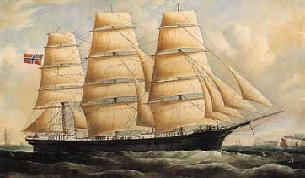 The origins of Fred. Olsen & Co. date back to 1848 when the Fred. Olsen family first entered the ship owning business. Over the years, companies related to the family have diversified into other activities, from aviation to shipbuilding, oil and gas exploration and development services, and have today wide international interests. The Fred. Olsen related interests comprise both private and publicly quoted companies. The public interests are centred around the two quoted Norwegian shipping companies Ganger Rolf ASA and Bonheur ASA, established in the 1890ies. The two companies co-operate closely on a 50/50 basis. Mr. Fred. Olsen is currently chairman of the two shipping companies and his daughter Anette S. Olsen is the Managing Director of same. The firm Fred. Olsen & Co., which is owned by Anette S. Olsen, provides administrative services to Ganger Rolf and Bonheur.
During the first half of the last century, cargo liner services were the main business area of the Fred. Olsen & Co. related activities. Combined passenger / cargo and ferry services were also developed, but are now largely disposed. A cruise operation (Fred. Olsen Cruise Lines) remains a fully owned affiliate. The Aker Shipbuilding and offshore construction group was majority owned by Bonheur and Ganger Rolf for about 70 years until sold in the mid 1980ies. The foundation of the Fred. Olsen & Co. companies was laid in the middle of the 19th century. The repeal of the Navigation Act in 1849 created favourable times for international trade and shipping, which the three brothers, Fredrik Christian, Petter and Andreas Olsen took advantage of. They lived in Hvitsten, a village on the Oslo Fjord, and became all sea captains at an early age. The eldest brother, Fredrik Christian Olsen, who was born in 1815, became a captain in 1841. He bought his first two sailing ships, the schooners "Johanne Christine" and "Elizabeth" in 1848. He died in 1875 having owned 22 sailing ships. Petter Olsen (1821 - 1899) bought his first ship, the brig "Thilda" in 1852. He owned a total of 16 sailing ships and part interests in several other ships. Andreas Olsen's (1826 - 1893) first ship was the barque "De Tre Venner", bought in 1860 and he subsequently owned five other sailing ships. The three Olsen brothers' activities gradually became so extensive that a customs station was built in Hvitsten. 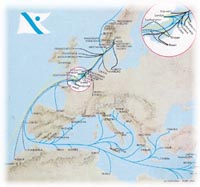 Thomas Fredrik (Fred.) Olsen (1857 - 1933), son of Petter Olsen carried the shipping tradition further. He became a sea captain at the age of 23 and held command of several of his father's ships. The build up of his own fleet started when "Bayard" and "Skien" were taken over from his father in 1886. During the following years the same happened with "Eda", Gerda" and "Nornen". In 1892 he had also bought "Cito", "Courant", Morning Light" and "Broderfolket". Fred. Olsen's fleet of sailing ships increased very fast.
Fred. Olsen had a definite aim: To create a network of regular liner services, firstly on the North Sea and later further afield. He believed that the way to success was to build up a reputation for service and dependability. As the visionary person he was, he well understood the need to transfer from sail to steam. In 1897 he therefore ordered his first steam ship, the "Bayard" of 1550 tons from Nyland Værksted in Christiania (now Oslo). In 1898 and 1899 the sister ships "Bonheur" and "Balduin" followed respectively, both built at the same yard. "Bayard" sailed between Fredrikstad and Garston (near Liverpool), whilst Bonheur operated a route Fred. Olsen established between Norway and London. In 1914 he participated in the Norwegian South America Line with Norway's first motor ship, the "Brazil" and he also contracted for several 10.000 t.d.w. motor ships. Fred. Olsen's shipping activities had now increased so much that in 1898 he moved his offices from Hvitsten to Oslo. The new established lines became a success and Fred. Olsen soon got the reputation as a dynamic and farsighted leader. This again resulted in inquiries to take over management of lines that had difficulties. In this way he took over the following lines and routes:
1900: The AS Ganger Rolf route from Norway to Rouen
1901: The A/S Færder route from Norway to Grange mouth
1906: Østlandske Lloyd A/S and the routes to Newcastle and Antwerpen
1912: The A/S Norden route from Norway to Holland
Fred. Olsen also opened new lines of his own, amongst others permanent sailings between Scandinavia and South America and between Norway and Baltic ports. He saw the possibilities for Norwegian shipping when the Panama canal was opened in 1914 and established liner services to ports on the USA west coast. 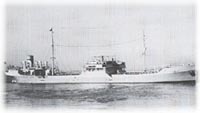 Fred. Olsen & Co. lost 23 of their 44 ships during the First World War, but the fleet was rapidly rebuilt. The activities expanded and in 1921, with the absorption of Otto Thoresen's lines, included the Mediterranean and Canary Islands. In 1923 Jeløylinjen's services to German ports were acquired.
Fred. Olsen & Co. built their first tanker M/T "Borgny" in 1929. At that time the building up of a modern fleet of fast freight services for the Mediterranean and the Canary routes started. When Fred. Olsen died in 1933 his sons Rudolf and Thomas Olsen carried on the firm and the main responsibility for further development. They became partners in 1914 and 1922, respectively. In 1916 the personal firm Fred. Olsen was changed to Fred. Olsen & Co.
During the years towards the second World War several cargo ships for the North Sea were built together with fast going fruit vessels for the Mediterranean line. During this period the modern and elegant passenger ships "Bretagne", "Black Prince" and "Black Watch" were built at Akers Mek. Verksted in Oslo.
Rudolf and Thomas Olsen further took the initiative to one of the first Norwegian airlines: The Norwegian Air Line Fred. Olsen and Bergenske A/S (DNL), a precursor to the post war period's Fred. Olsen Flyselskap and major interests in DNL / SAS, Widerøe and Sterling. 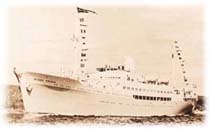 When Norway was attacked 9 April 1940 the ships of the Fred. Olsen Lines were spread over half the globe. Every vessel that was not actually in a Norwegian or enemy occupied port immediately went into allied war service. The war losses were large. By the end of the war in 1945 28 ships had been lost, i.e. the half of the shipping company's fleet. The foreign activities during the war years were managed by Thomas Olsen.
During the post war years an active fleet reconstruction period followed. In the rebuilding the main aim was to ensure that each line was served by ships of the best and most suitable design for the trade in question. New fast liners had large refrigerated, air conditioned and electrically ventilated holds for meat, fish, fruit and dairy produce. New North Sea vessels were constructed for fully mechanized handling of palletised general cargo by means of side ports and the "truck to truck" system besides conventional deck cranes and heavy-lift derricks. Capacities and sailing frequencies in this way increased. In the 1970ies the introduction of roll-on roll-off vessels increased productivity further.
The passenger trades in the North Sea have long traditions in Fred. Olsen Lines and was strengthened by the new sister ships "Braemar" and "Blendheim" in the beginning of the 1950ies. The two combined cargo, car and passenger vessels "Black Watch" and "Black Prince" for UK / Canary and ferry services in the North Sea came in 1966. The latter was later developed into Fred. Olsen Cruise Lines. Kristiansand Dampskipselskap, operating ferry services to Denmark, was acquired in 1968 and further expanded until it was sold in 1991.
Rudolf Olsen died in 1951. Thomas Olsen became ill in 1955 and passed away in 1969, His son, Fred. Olsen became a partner in 1955 and managed the companies until his daughter Anette S. Olsen became manager of Fred. Olsen & Co. in 1994. 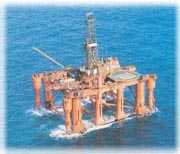
As early as in the middle of the 1960'ies Fred. Olsen saw the possibilities within the oil sector, especially oil exploration. He co- founded the Norwegian Oil Consortium (NOCO) and later Saga Petroleum A/S. This proved to be a success. Through a 45 % ownership in NOCO, the companies had a considerable engagement within oil exploration, oil refining and sale of oil. These interests were sold in 1991. Also within the offshore sector the Fred. Olsen & Co. - companies have been among the pioneers in Norway. Within a fast increasing oil- and offshore market an offshore division was built from 1974 with Dolphin International Inc., Houston and later Dolphin A/S Tananger and Dolphin Drilling Aberdeen as the operating companies. Fred. Olsen & Co. was an initiator for the construction of the Aker H-3 semisubmersible drilling rigs and in the 1970ies ordered several units. Dolphin, who operates the rigs, has proved to be an international operator and completed big offshore jobs in the North Sea, the Mediterranean, the Gulf of Mexico and also outside South America, Alaska, Sakhalin, Australia and Indonesia. The Dolphin companies were at an early stage active within related services such as engineering, well maintenance, diving services and remote controlled submarines. These activities were later sold. Fred. Olsen Production was established in 1994 and has developed a number of projects within floating production.
In 1997 the offshore and energy-related activities were merged into Fred. Olsen Energy ASA (FOE), a new, independent company. After a successful share issue of app. USD 285 mill. Tanker shipping has for a long time been an important investment area. Since 1929 Fred. Olsen-related companies have operated more than 40 tankers, altogether over 5 mill. dwt. The tanker fleet was sold in 1972/73, but Ganger Rolf and Bonheur again entered into the tanker market in 1986 and acquired a number of Suezmaxes and VLCCs. In 1993 these investments were consolidated into a new company, First Olsen Tankers Ltd., Bermuda. After a share issue of USD 108 mill. in October 1993 FOTL was quoted on the Norwegian Stock Exchange until 1999. The company, which is re-named First Olsen Ltd., is 100 % owned by Bonheur and Ganger Rolf. The first investment in renewable energy was done in 1997 - in a wind power park in Scotland. Through Fred. Olsen Renewables AS a number of wind power projects have later been developed and realized, as a continuation of the Fred. Olsen companies' wide engagement in energy-related activities. Fred. Olsen Renewables is active in projects in Norway, Sweden, Ireland and the UK. |
|